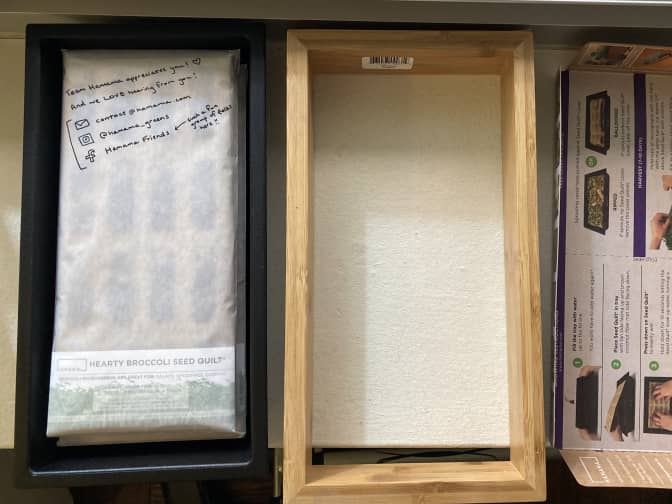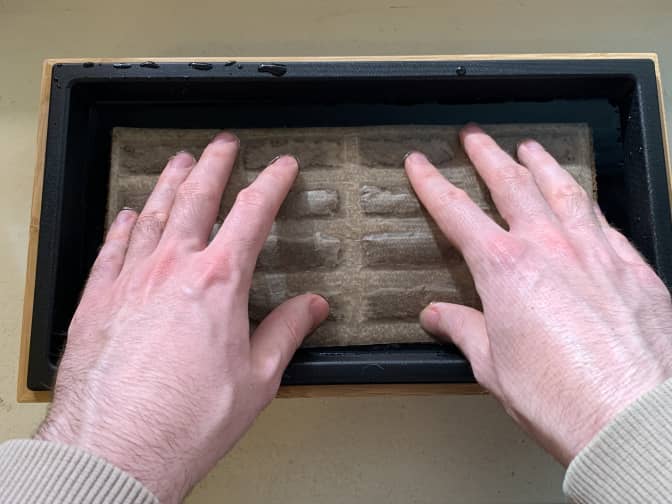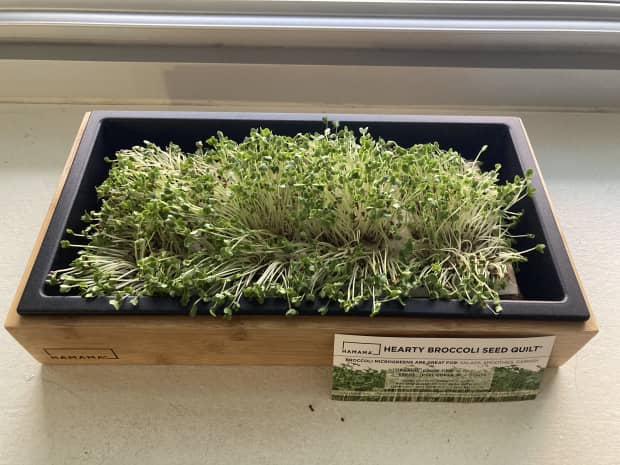

We tried it: How to Use the Hamama Microgreens Grow Kit
Last Updated: June 21, 2022
Another houseplant wither under your watch? You’re not alone. Grove writer Harry Rabinowitz tried the Hamama Microgreens Growing Kit to see if edible microgreens could thrive ... even under his care.
- We tried it: How to Use the Hamama Microgreens Grow Kit
- For plant-killers everywhere: The Hamama Microgreens Grow Kit
- The Hamama Grow Kit experience: From unboxing to harvesting
- The verdict: Hamama Microgreens are fun, easy, and tasty!
- Get growing with more of Grove’s organic gardening products
- Read more from Grove
I have never been able to grow plants in my apartment. I’ve tried growing hardy jade, no-fuss aloe, and fast-spreading ivy. They all met their end somewhere on my balcony or windowsill.
What’s especially terrible about all this is that I love plants. It’s easy to blame things other than me, like my apartment’s inconsistent light, New York City’s inconsistent weather, my building’s inconsistent heat. But, if we’re being real here, I clearly lack a green thumb.
I sucked up my pride, though, to give this Hamama Microgreens Grow Kit a real try. Here’s what happened.

For plant-killers everywhere: The Hamama Microgreens Grow Kit
On paper, the Hamama Microgreens Grow Kit sounds perfect for a vegetarian plant-killer-slash-plant-fan-boy like me. It’s a fully loaded kit with everything you need to grow your own microgreens at home, and it's dead simple.
Unlike growing plants at home with potting soil, plant food, and watering to worry about, the Hamama Microgreens Kit has no soil, no pots, and only needs to be watered once.
The microgreens are grown in a seed quilt, which is a flat sheet of seeds inside a “soil” of compostable paper, coconut, and other natural fibers. And according to Hamama, the seeds can thrive in low or even artificial light and only take 7–10 days to fully grow.
This all sounded way too good to be true. Not one to fall for marketing tactics, I ordered a Grow Kit for myself, and put it to the test.
The Hamama Grow Kit experience: From unboxing to harvesting

Unboxing the Hamama Grow Kit
My kit came with a BPA-free plastic growing tray, a pretty bamboo tray to hold the growing tray, two seed quilts, the “Hearty Broccoli” and “Super Salad Mix,” and a paper instruction card, all packed neatly into the growing tray itself.
As I took everything out of the tray, I was struck by how simple and minimal it all seemed. I was also struck by how well the bamboo tray frame fit in with the aesthetic of my space.

Hamama Grow Kit instructions
The paper instructions (Printed using soy ink on biodegradable paper!) were very clear and detailed. After reading, I cleared a spot on my windowsill and started planting.

Planting the seed quilt
Planting the seed quilt was incredibly simple. As instructed, I filled the plastic growing tray with water up to the printed white line. Then, I unwrapped the seed quilt and pressed it down into the water-filled tray for about 10 seconds, making sure to press down all sides and corners of the quilt for maximum water absorption.
And that was that! All that was left was to wait, wait some more, and wonder. (I did say a few positive affirmations in the general direction of my seed quilt, but I believe that is optional.)

Growing the microgreens
For the first few days, the growing process was slow with not much movement within the seed quilt. But, on the fourth day, as you can see in the picture, the broccoli sprouts started pushing against the top of the seed quilt, followed by the Super Seed Mix sprouts a couple of days later.

As instructed, I peeled away the top layer of the seed quilt and waited a few more days.
The second half of the growing process was much more dramatic than the first, with the sprouts growing big and tall in only a few days. Suddenly, around day eight, it was time to harvest!


March 10

March 11

Harvesting, eating, and storing the microgreens
I took a pair of scissors and chopped the greens at the base of the quilt. It was a bit of a delicate process, but the end result was a big bowl of fresh microgreens and a well-used, compostable seed quilt.
As recommended by Hamama, I stored the microgreens on a dry paper towel in an air-tight container in the fridge. The microgreens were tasty toppings to that week’s sandwiches, salads, soups, and smoothies.

Shop the Microgreens Grow Kit
This homegrown Microgreens Starter Kit includes a reusable grow tray, beautiful bamboo frame, easy instructions, 1 Super Salad Mix Seed Quilt, and 1 Hearty Broccoli Seed Quilt.
It works in low light and comes with all non-GMO seeds. Each seed packet grows in a week — just add water.
Which microgreens were the best to eat?
The broccoli microgreens had a bit of a spicy flavor to them, while the Super Salad Mix tasted more earthy. They were both very fresh and very delicious!
After harvesting: Cleaning and replanting
The plastic growing tray was barely dirty after the first seed quilt harvest, and, after a simple soap and water wash in the kitchen sink, it was ready to go again.
The verdict: Hamama Microgreens are fun, easy, and tasty!
As someone notorious for killing plants, I was shocked at how easy it was to plant, grow, and harvest using the Hamama Microgreens Grow Kit. With minimal work or fuss, I had fresh microgreens to eat just eight days after planting.
Of the two seed quilts I used, the Broccoli Quilt grew much faster — and much fuller — than the Super Salad Mix. Since I grew both the exact same way, I’m not sure why the Super Salad Mix had a smaller yield, but both were fun and exciting to grow regardless.
If you are an apartment dweller and vegetable lover, or just want to try your hand at growing microgreens, I highly recommend giving the Hamama Microgreens Grow Kit a try. I was more than satisfied with the experience and happy to have tasty greens to eat at the end of it!

Harry Rabinowitz is a writer who’s always looking to learn something new. He’s been writing for Grove since 2020.
What is Grove Collaborative?
From natural household to personal care, everything at Grove is healthier for you and the planet — and works! We recommend monthly shipments and product refills that you can edit or move at any time. No monthly fees or commitments required.
Read more from Grove

The germiest household items most people forget to clean.
The most overlooked things in your home you should be cleaning right now.
Read More

Are flour bugs harmful? 6 natural tips to keep them out!
Banish flour-eating fiends with these natural tips and tricks on flour bug prevention.
Read More

The 11 best bamboo products for the environment.
Here are 11 bamboo products that are eco-friendly and highly rated by our members.
Read More

Grove's guide to going plastic-free at home.
How to go plastic-free if you're just getting started — and how to level up if you're ready to make a commitment.
Read More
